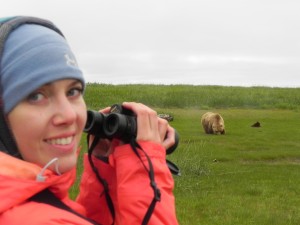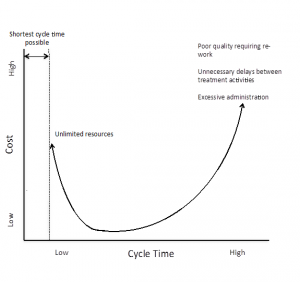Introducing Palliative Care to a remote Alaskan island
Dr. Eleanor M. Jansen trained as a General Practitioner in the UK, and after getting married, moved to the remote island of Kodiak, Alaska where her husband works. She now co-ordinates a palliative care service on the island, and describes her journey, here.
Living on Kodiak Island, Alaska, the hardest part of my day may actually be making it as far as the hospital entrance: scraping layers of ice from the windscreen, driving the treacherous miles, remembering to park into the wind so my truck door isn’t ripped off, and tip toeing across the parking lot in my ice cleats, looking out for that bear who refuses to hibernate.But once I make it through the door, helping to implement a new palliative care service at Providence Kodiak Island Medical Center has it’s own challenges. The team formed about a year prior to my entering as coordinator and there was already enthusiasm from several hospital disciplines to bring an extra layer of support to patients and families dealing with serious and life-threatening illness.My main challenges are to bring structure to the service, promote the team, educate and plan for the future.
Reading America’s Care of Serious Illness: A State-by-State Report Card on Access to Palliative Care in Our Nation’s Hospitals, a 2011 collaboration between the Center to Advance Palliative Care (CAPC) and the National Palliative Care Research Center (NPCRC) [1], I feel proud that our little 25 bed hospital has a service at all. Palliative care is one of the fastest-growing trends in US health care and the number of programs within hospital settings has increased by 138 percent since 2000, yet, despite those nationwide improvements, just 2 out of 7 small hospitals in Alaska, with under 50 beds, have a Palliative Care program.
A needs assessment and defining exactly your scope of practice are among the first tasks of setting up a program. Thanks to, among others, CAPC and their wealth of publicly available tools and resources, there is plenty of information available. I encourage programs not to reinvent the wheel, but to seek tools already in use and adapt these to the needs of your team.
Beware of selling yourself before your systems, protocols and forms are in place, but do think ahead about advertising your team. There will be pressure to market the service early on, but don’t touch the tar baby! A recent audio conference from CAPC highlighted palliative care services becoming quickly saturated is a common downfall in the start-up phase.Establish relationships with disciplines outside the team – nursing staff, pharmacy, administration – as they will be your advocates and a tremendous support. I also recommend reaching out to various resources and finding out what else is out there to support your service. Here in Kodiak I have made close ties with Home Health (similar to District Nurses), the new volunteer Hospice of Kodiak and I am getting to know about other resources such as the “Senior Center.”
Educating staff about the palliative care team’s role is an ongoing challenge. Recent opinion polling revealed that palliative care is relatively unknown to the US public and poorly understood by many health care providers [2]. Palliative Care’s relationship with hospice is also misunderstood. Here in the US, hospice has more defined parameters based upon prognosis, relinquishing curative treatment, etc. Helping physicians see that early referral to palliative care, in some cases at the time of diagnosis, can help tailor care to patient goals and improve quality of life. Meeting with doctors and other staff on a one-to-one basis and presenting at medical staff and admin meetings has been most effective at promoting the team. Putting together a short ‘elevator speech’ is useful too in those “crunch time” moments. It is worthwhile advertising the service as a time saver to physicians and a team who can have those long and often difficult conversations about treatment decisions, advance care planning, resuscitation and so on.
It has been equally essential to keep the patient’s primary physician central to care and to be seen as additional support versus taking over. In Kodiak, the family physician comes to the hospital to manage the patient. Understandably, physicians here in Kodiak are protective of their patients and the only hand over from family physician-to-hospital staff comes if the patient needs to be flown to a distant facility for treatment unavailable on Kodiak Island. As a GP in the UK, I often breathed a sigh of relief when I handed over a very sick patient to a higher level of care at the hospital, as I knew I was reaching the limits of what I could do in the community. No such relief for physicians here.
What is clear to me, being in a new country, system and environment, is that different places have different habits and things ‘have always been done that way.’ Introducing a new branch of medicine, with it’s growing evidence base, can challenge those traditional ways of doing things, and can take time and effort to be accepted.The son of a patient who died said to me the other week that the involvement of palliative care had brought ‘a sense of calm.’ If that is what we achieve for families, then our efforts bringing palliative care to this island are beginning to come to fruition.
References:
[1] America’s Care of Serious Illness: A State-by-State Report Card on Access to Palliative Care in Our Nation’s Hospitals, May 2011. Available at http://www.capc.org/reportcard/
[2] Center to Advance Palliative Care. 2011 public opinion research on palliative care: A report based on research by Public Opinion Strategies. Available at: http://www.capc.org/tools-for-palliative-care-programs/marketing/public-opinion-research/2011-public-opinion-research-on-palliative-care.pdf





